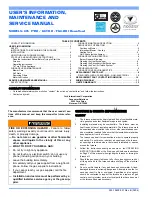
46
440 01 4801 00
Specifications subject to change without notice.
Representative drawing only, some models may vary in appearance.
TO CODE--APPROVED DRAIN OR CONDENSATE PUMP
Tee
Dry Well
Cap
(water tight
and removable)
Tee
Dry Well
Cap
(water tight
and removable)
Tee
Dry Well
Cap
(water tight
and removable)
Recommend “T” fitting with 4--inch minimum height standpipe (
A
) of same diameter or larger extending upward.
A
A
A
A170122A
Fig. 51 -- Recommended Combustion Air Inlet Moisture Trap
ADDITIONAL INFORMATION FOR
POLYPROPYLENE VENTING SYSTEMS
Polypropylene venting systems include flexible vent pipe.
These flexible vent pipes have a different equivalent vent
length than straight sections of PVC/ABS DWV vent pipe. Be
sure to make the appropriate deductions from the Maximum
Equivalent Vent Length (MEVL), or additions to the Total
Equivalent Vent Length (TEVL), when applying flexible vent
pipes
in
polypropylene
venting
systems.
See
the
polypropylene vent system manufacturer’s installation
instructions for details.
When using metric-sized venting systems, use these
equivalencies for obtaining the proper MEVL from the Tables:
Use 2” Vent Tables for 60 mm (o.d.) vent systems
Use 3” Vent Tables for 80 mm (o.d.) vent systems
Use 4” Vent Tables for 100 mm (o.d.) vent systems
NOTICE
NOTE
: Polypropylene venting systems MAY require additional
deductions from the MEVL, or additions to the TEVL, for vent
terminations and flexible pipe sections. See the polypropylene
venting system manufacturer’s instructions for details on
equivalent lengths of vent terminations and flexible vent pipes,
and for calculating total vent lengths.
To calculate the Total Equivalent Vent Length (TEVL) of the
venting system:
1. Measure the individual distance from the furnace to the ter-
mination for each pipe.
2. Count the number of elbows for each pipe.
3. For each pipe, multiply the number of elbows by the equiv-
alent length for the type of elbow used. Record the equiva-
lent length of all the elbows for each pipe.
4. If a Tee is used on the termination (Alberta and
Saskatchewan, when required) record the equivalent length
of the Tee used.
5. Calculate Total Equivalent Vent Length by adding the
equivalent lengths of the fittings to the lengths of the indi-
vidual vent and combustion air pipes.
6. When using polypropylene venting systems with flexible
vent pipes, perform adjustments for the equivalent length of
the flexible vent pipe to the calculated total equivalent
venting system length. See the polypropylene vent system
manufacturer’s instructions for details.
7. Select a diameter of vent pipe from Table 13 and note the
Maximum Equivalent Vent Length (MEVL) shown for that
application for that specific furnace input size. Compare the
Total Equivalent Vent Length (TEVL) to the MEVL:
8. If the Total Equivalent Vent Length is
shorter
than the
Maximum Equivalent Vent Length for the diameter of pipe
chosen, then that diameter of pipe selected may be used.
















































